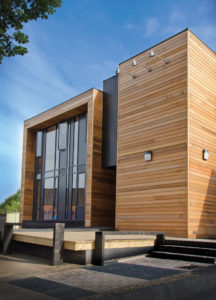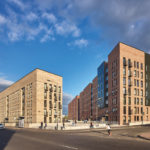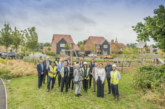Versatile, renewable and highly sustainable, structural timber offers a rapid solution to the UK’s ongoing housing crisis — yet misconceptions still exist regarding its suitability for large-scale construction. In this article, Andrew Orriss discusses how social housing providers can use structural timber to swiftly deliver volume housing, while also meeting their carbon reduction obligations.
In the wake of the COVID-19 pandemic, the housing crisis is once again in the spotlight — with the UK lagging behind housing demand in terms of both supply and quality. Most notably, the lockdowns of 2020 have highlighted the urgent need to improve the availability of social housing — particularly for the millions of families living in substandard private rented homes or temporary accommodation. Certainly, the sector must follow the Prime Minister’s instruction to “Build, build, build”, but priority must be given to delivering genuinely affordable social homes — and this must be achieved at pace, while also keeping environmental obligations in mind.
With the industry targeted to achieve net zero carbon by 2050, widespread use of structural timber would make this lofty goal more attainable. In many ways, structural timber can be seen as the ‘net zero hero’ for the sector, allowing it to meet these overarching targets effectively. For one, the material is particularly suited to modern methods of construction, such as offsite and modular design, as it is clean and easy to process within factories. What’s more, the timber industry has robust and mature supply chains, meaning a steady flow of materials can be ensured. These innovative approaches to long-standing construction challenges are enabling the rapid delivery of homes, particularly for social housing providers and local authorities.

Reducing carbon emissions
In addition to these benefits, structural timber has a key role to play in reducing the overall carbon emissions of the construction industry. As trees grow, they naturally absorb carbon, which continues to be stored when the material is transformed into structural timber products. Importantly, timber absorbs and stores more carbon than it emits during processing and installation — so these engineered solutions act as an effective carbon store when used as part of a building. When the building has reached the end of its use, this stored carbon can either be re-used as fuel, or will naturally filter back into the soil.
By comparison, the use of concrete and steel within construction leads to considerably more energy and carbon usage. To this end, a report published by Chatham House (Making Concrete Change: June 2018) shows that cement is the source of 4-8% of total global carbon dioxide emissions. In fact, when used instead of other building materials, a single cubic metre of timber will save around 0.8 tonnes of carbon dioxide emissions.
With such strong green credentials, it’s clear to see why so many organisations are embracing timber. Not only does the material provide strength and aesthetic beauty, it offers an effective solution in battling climate change. In fact, as far back as 2012 the borough of Hackney in East London was forging ahead, by adopting a planning policy that favours wood, where feasible, as the primary construction material. Similarly, the French government recently announced new sustainability legislation to help make the country carbon-neutral by 2050. The new law, which becomes enforceable in 2022, will mandate that all new public buildings in France are built from at least 50% timber, or other natural materials.
 Challenging misconceptions
Challenging misconceptions
Despite all this, efforts to expand the use of timber within the UK are being held back to some extent by misconceptions regarding its suitability for certain construction purposes. Most notably, there remains a long-held, incorrect assumption about the fire risk of structural timber — meaning some social housing providers and local authorities may be put off using the material. Whilst this approach is well intentioned, it’s undoubtedly doing more harm than good, with local authorities missing out on the benefits that this versatile material can offer.
Therefore, when setting forth plans to overcome the extensive challenges that they currently face, social housing providers and local authorities are urged to consider incorporating more structural timber designs into their operations. As well as offering a more sustainable construction option, the material is helping organisations to build quality homes faster. As such, not only does the material represent an obvious, sustainable and environmentally positive solution, which can help to drive down total carbon emissions, but an avenue to accelerate social housing delivery at a time of considerable strife.
The Time for Timber campaign aims to further amplify this important message and ensure that all levels of the social housing sector feel confident in designing, specifying and installing structural timber solutions into new homes. In doing so, we believe we can help to usher in a new era of responsive, environmentally friendly construction, which will benefit all parties.
With thanks to Andrew Orriss from the Time for Timber campaign for preparing this article









